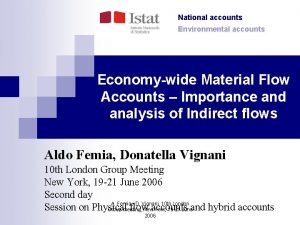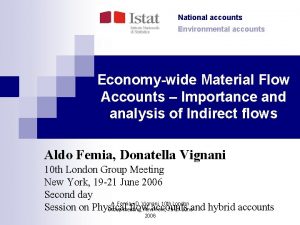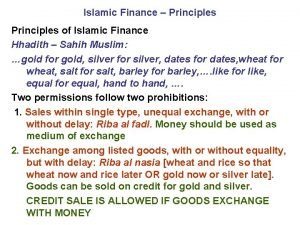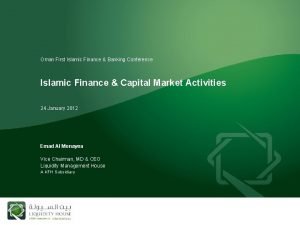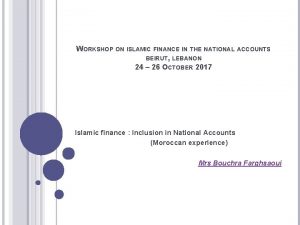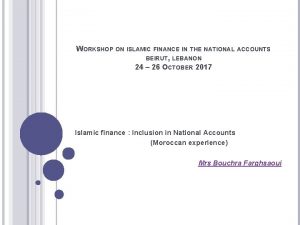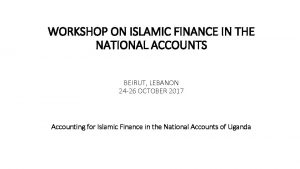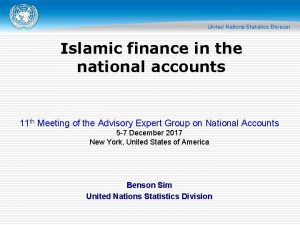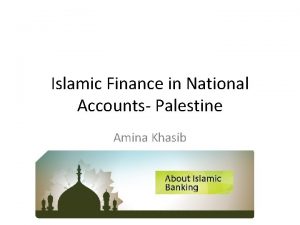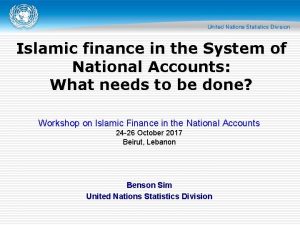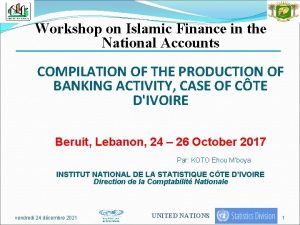Islamic finance in the national accounts 12 th
















- Slides: 16

Islamic finance in the national accounts 12 th Meeting of the Advisory Expert Group on National Accounts 27 -29 November 2017 Luxembourg United Nations Statistics Division

Outline of presentation § § § Background Discussions at Ankara workshop Key outcomes Immediate next steps Questions for the AEG 2

Background § § 11 th AEG meeting discussed recommendations of the Task Force on Islamic Finance arising from the Beirut workshop Key recommendation - formation of two working groups • • Working group on sectorization and classification Working group on data collection and coordination 3

Discussions at Ankara workshop § A workshop was organized in Ankara, Turkey, from 31 October-2 November 2018 to discuss • • • § Draft classifications of Islamic financial instruments and the corresponding property income Draft sectorization of Islamic financial corporations and methods to calculate output of Islamic financial services Draft diagrams to show the flows between Islamic financial corporations and their clients for various Islamic financial instruments Workshop resulted in a number of key outcomes 4

Key outcomes Classification of Islamic financial instruments and corresponding property income § § § There was agreement on the proposed recommendations on the classification of Islamic financial instruments and their corresponding property income (see annex 1), except for those Islamic financial instruments which are classified as deposits, loans and debt securities For these three groups of Islamic financial instruments, more research should be carried out on how to reconcile the classification of their property income as interest and the prohibition of interest in Shari’ah law For completeness, the list of Islamic financial instruments should be expanded to include synthetic Islamic financial derivatives 5

Key outcomes Classification of Islamic financial instruments and corresponding property income § There was agreement with the diagrams which have been prepared to illustrate the flows between Islamic financial corporations and their clients for various Islamic financial instruments to help better understand how to record these flows in the national accounts (see annex 2) 6

Key outcomes Sectorization of Islamic financial corporations and calculation of output § There was agreement with the proposed classification of Islamic financial corporations and the corresponding methods to calculate the output of Islamic financial services (see annex 3), except for the output of Islamic financial corporations which are allocated to the deposittaking corporations except the central bank subsector (S 122) 7

Key outcomes Sectorization of Islamic financial corporations and calculation of output § For the output of these Islamic financial corporations, more research should be carried out on • • • How interest on loans and deposits can be accommodated in the FISIM formula to calculate the financial intermediation services associated with Islamic financial instruments which are classified as deposits and loans Whether FISIM should be calculated for zero-return deposits and loans Evaluation of the use of two reference rates (one for conventional FISIM and one for Islamic FISIM) versus a single reference rate for each currency type 8

Key outcomes Sectorization of Islamic financial corporations and calculation of output § § Islamic financial corporations which take deposits (for example, Amanah, Hiba and Wadiah) should be sectorized to S 122 and Islamic financial corporations which manage Shari’ah-compliant investment funds should be sectorized to S 126, if separate institutional units are formed for these purposes For completeness, the list should be expanded to include • • Family-established units for investment purposes (i. e. , waqf) and national-level Shari’ah advisory boards if they provide financial services Informal Islamic financial entities and activities such as Sadaka and Zakat 9

Key outcomes Sectorization of Islamic financial corporations and calculation of output § Countries which have developed methods to measure the output, value added and other flows of Islamic windows to share their methods, ideally through the use of illustrative worked examples 10

Key outcomes Input data for calculating Islamic finance statistics § § Income statements and balance sheets of Islamic financial corporations from the central bank and supervisory authorities should be used to derive Islamic finance statistics in the national accounts Countries which are conducting additional surveys to collect data to calculate Islamic finance statistics should share their survey forms to help in the development of a standard survey form 11

Key outcomes International initiatives to collect data on Islamic finance § § There was progress in the initiatives undertaken by international and regional organizations such as the partnership between IFSB and SESRIC to collect and disseminate statistics and indicators on Islamic finance A stock-taking exercise using a matrix to determine the list of international and regional organizations which are collecting data and indicators on Islamic finance, the data and indicators which are collected and accompanying metadata and country coverage needs to be undertaken 12

Key outcomes Possible future initiatives § § Further work on how data on Islamic finance can meet policy and academic needs is needed A group comprising representatives from national statistical agencies, banking and supervisory authorities, central banks, international and regional organizations for this purpose should be formed 13

Immediate next steps § To consult and the task force and AEG on the outcomes of the workshop 14

Questions for the AEG § The AEG is requested to provide comments on the progress of the work of the task force 15

Thank you 16
 Habib metro
Habib metro Derivatives in islamic finance
Derivatives in islamic finance York national accounts
York national accounts The national income and product accounts
The national income and product accounts Systems of national accounts
Systems of national accounts System of national accounts (sna)
System of national accounts (sna) Advisory expert group on national accounts
Advisory expert group on national accounts National finance commission
National finance commission National finance commission
National finance commission National finance center
National finance center![Yong ung kai v. enting [1965] 2 mlj 98 Yong ung kai v. enting [1965] 2 mlj 98](data:image/svg+xml,%3Csvg%20xmlns=%22http://www.w3.org/2000/svg%22%20viewBox=%220%200%20200%20200%22%3E%3C/svg%3E) Yong ung kai v. enting [1965] 2 mlj 98
Yong ung kai v. enting [1965] 2 mlj 98 Hình ảnh bộ gõ cơ thể búng tay
Hình ảnh bộ gõ cơ thể búng tay Lp html
Lp html Bổ thể
Bổ thể Tỉ lệ cơ thể trẻ em
Tỉ lệ cơ thể trẻ em Gấu đi như thế nào
Gấu đi như thế nào Tư thế worms-breton
Tư thế worms-breton


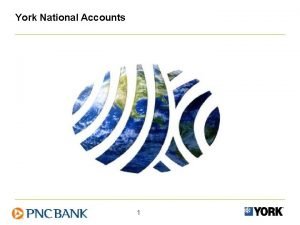

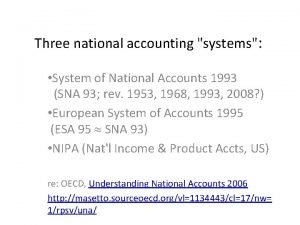
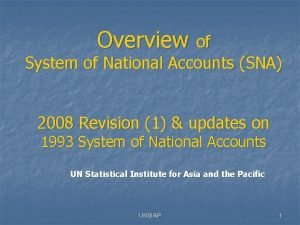
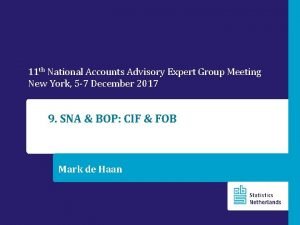
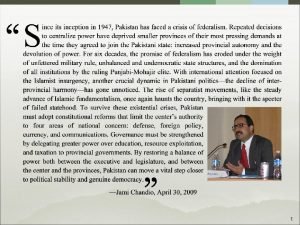

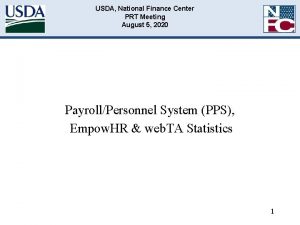
![Yong ung kai v. enting [1965] 2 mlj 98 Yong ung kai v. enting [1965] 2 mlj 98](https://slidetodoc.com/wp-content/uploads/2020/12/2883477_bfaf68d6692e33eec6aa94be191b7318-300x225.jpg)







